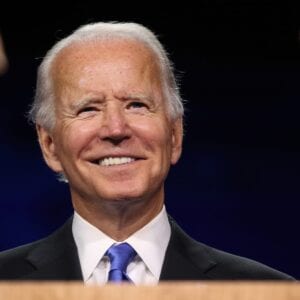Biden memo promises better days for Indian Nations

 RAPID CITY— Most tribes are greatly encouraged by the memorandum issued by President Joe Biden last week, calling for better consultation between tribes and the federal government. Biden’s memorandum is a reaffirmation of Executive Order (EO) 13175 issued by President Clinton in November, 2000. President Obama also issued a similar affirmation memorandum in 2009. The need to issue an EO, followed by two affirmation memorandum on the specific topic of consultation between tribes and the federal government, speaks to tribal dissatisfaction with the process at the time of the issuance, and the difference in response between a Democratic administration and a Republican one.
RAPID CITY— Most tribes are greatly encouraged by the memorandum issued by President Joe Biden last week, calling for better consultation between tribes and the federal government. Biden’s memorandum is a reaffirmation of Executive Order (EO) 13175 issued by President Clinton in November, 2000. President Obama also issued a similar affirmation memorandum in 2009. The need to issue an EO, followed by two affirmation memorandum on the specific topic of consultation between tribes and the federal government, speaks to tribal dissatisfaction with the process at the time of the issuance, and the difference in response between a Democratic administration and a Republican one.
The following is from a National Congress of American Indians (NCAI) December 14, 2009, letter to then Secretary of Agriculture, Tom Vilsack:
“In general, tribal leaders have strongly supported EO 13175, but have significant concerns about the way it has been implemented. Tribal concerns boil down to two points: 1) The Executive Order is viewed by federal agencies as merely a procedural requirement with no focus on the substantive goals of tribal self-government and fulfillment of the federal trust responsibility. Tribal leaders spend a great deal of time and resources engaging with a federal agency only to receive little response directed toward tribal recommendations. 2) Sometimes federal agencies ignore or refuse to carry out their responsibilities under the Executive Order, and there are no mechanisms for accountability.”
Taking the two points raised by NCAI in turn, we find that the concerns raised by NCAI are inherent in the nature of the EO and any memorandum. First, that the EO “is viewed by federal agencies as merely a procedural requirement with no focus on the substantive goals of tribal self-government and fulfillment of the federal trust responsibility.” This is understandable given the exact wording at the end of the EO and the reaffirmation memorandum, which reads: “…intended only to improve the internal management of the executive branch, and is not intended to create any right, benefit, or trust responsibility, substantive or procedural, enforceable at law by a party against the United States, its agencies, or any person.”
Federal agencies perceive the EO and the subsequent reaffirmation memorandum as nonbinding procedural directives because that is exactly what they are. Under a president hostile to the intent of EO 13175, all federal agencies would be under no legal obligation to follow the EO, and this is exactly what happened during the Bush Administration (2001-2008), and under the Trump Administration (2017-2020).
The second point raised by NCAI in 2009, that federal agencies sometimes “ignore or refuse to carry out their responsibilities under the Executive Order, and there are no mechanisms for accountability,” follows hand over fist given the EO is not a Congressional mandate. An EO, no matter its intent, has no teeth by definition, beyond the honor bound commitment of a given administration, and so no enforcement mechanism can exist.
Executive Director of the Great Plains Tribal Chairman’s Association, Gay Kingman, was a strong critic of the consultation process under President Trump, and although she believes that the consultation process overall can be much improved, it was much better during the Obama Administration.
“President Obama was trying to get (tribal) advisory boards to the Secretary and various agencies of government,” Kingman said. “That advisory board would advise the agency. That’s an example of what could be better. The Department of Energy has an Indian advisory board. Same thing, the Department of Agriculture has an advisory board.”
Structural mechanisms differ from procedural directives in that they must be followed by law, despite the political perspective of any presidential administration. Neither EO 13175, nor the subsequent reaffirmations, establish that structural mechanism, and this was no accident, but clearly defined at the end of all three issuances, by design.
Section 5 of EO 13175 is entitled “Consultation.” Subsection d) states: “On issues relating to tribal self-government, tribal trust resources, or Indian tribal treaty and other rights, each agency should explore and, where appropriate, use consensual mechanisms for developing regulations, included negotiated rulemaking.”
“Consensual mechanisms” and “negotiated rulemaking” are the heart-and-soul of give-and-take consultation, but a structural mechanism cannot by definition be consensual, since it is a mandate and not a directive. So, too, good faith negotiation cannot exist, if the federal agency shows up at the consultation, hears out the tribes, and then implements what it already decided before it left the agency. In this way, any policy is only as applicable as any administration desires it to be. This is the direct consequence of the deliberate wording at the end of each issuance.
Kingman’s accurate observation, that “there wasn’t a give-and-take. Tribes didn’t have the ability to consult under Trump,” clearly indicates Republican administrations do not feel honor bound to the spirit or the procedures of any EO or memorandum issued by a Democratic administration.
Tribes must ask themselves if this is a consequence of a specific GOP hostility towards tribal interest, or the predictable result between two warring political parties willing to ignore or subvert any policy directives issued by the other. Tribes must then ask themselves why the Democrats have never attempted to establish structural mechanisms mandating the policies an EO or a memorandum can only de facto advocate, if they are indeed, our friend.
Kingman’s enthusiasm about the Biden memorandum is justified, given the history since EO 13175 was issued. But, so too, tribal interest can be tainted by too close an identification with one political party over another. Do prominent figures in Indian Country watch what they say publicly for fear of offending those deeply invested in the policy narrative of a dominant culture political party, and not the independent tribal interest in the topic at hand? Legitimately raising the concern, that their loyalty to the tribes may be no greater than their loyalty to an alien political structure traditionally averse to fundamental tribal interest.
Looking back over the past half century, we see where the 1968 Civil Rights Act was amended to provide structural mechanism in defense of tribal civil liberties and rights. So direct binding structural reform is possible. This amendment was a consequence of President Johnson’s era of the Great Society, and was not a change the GOP at the time readily supported.
President Nixon’s subsequent defeat of Vice President Hubert Humphrey initially set off alarm bells when he abolished the Office of Economic Opportunity. Oglala Sioux tribal member Jim Wilson manned the Indian desk at that now defunct agency and accomplished much good during his time there. But Nixon then turned out to be one of the better presidents when it came to tribal interest. His July 8, 1970, message to Congress set a tone of “Self Determination without Termination” for Indian tribes that resulted in the Indian Self Determination Act a few years later. Concrete and lasting benefit also came from the GOP White House, such as the return of 50,000 acres of the Kit Carson National Forest in New Mexico to the Taos tribe.
Democratic Senator Bill Bradley’s sponsorship of a bill to return a large part of the Black Hills a decade after Nixon, reestablished the Democratic Party as the party most tribal members trusted and voted for. Although the Bradley Bill never became law, back home in South Dakota, the Democrats still enjoyed the loyal support of most tribes, and still do. This despite not one Democratic senator or representative (that being Tom Daschle, Tim Johnson or Stephanie Herseth), openly supporting the issue most important to all tribes, the return of the sacred Black Hills. In fact, Daschle openly worked against it.
After President Clinton issued EO 13175, Vice President Al Gore lost to George W. Bush in the 2000 presidential race, and after President Bush won reelection in 2004, eight years would elapse before the EO could be properly applied to government policy. Now that President Trump has been defeated, and President Biden has issued his memorandum reaffirming EO 13175, most of Indian Country is enthusiastic about the change in policy.
However, tribes never took advantage of the eight years President Obama held the White House, despite the promise of an open door to negotiate substantive change. President Obama waited for tribes to get on the same page, come to Washington with specific proposals and demands, but this never happened.
Tribes once again have a president with a sympathetic ear, and his memorandum is an olive branch extended, an open door invitation to establish a deeper and more structurally supported trust relationship between tribes and the federal government. Beyond the overarching plenary power of Congress, there is much territory for structural mechanisms to be negotiated and empowered that would provide lasting protection and opportunities for tribes to address and rectify their most pressing interests.
The 2009 NCAI letter to Tom Vilsack indicated that, even 11 years back, tribes were well aware of the opportunity then presented by EO 13175 and the first reaffirmation from President Obama: “Although these are serious concerns about the consultation process, tribal leaders acknowledge that the EO is a useful tool for improving the federal-tribal relationship, and that some consultation processes have worked well and generated positive and substantive results.”
What remains is for tribes to come together, and respond to the Biden administration memorandum, united and focused for the good of all Indian Country. Tribes have at least four years to get that done.
(Contact James Giago Davies at skindiesel@msn.com)
The post Biden memo promises better days for Indian Nations first appeared on Native Sun News Today.
